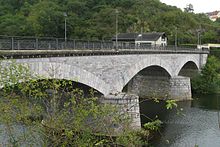Marble Bridge (Villmar)
| Marble bridge | |
|---|---|

|
|
| Technical specifications | |
| length | approx. 85 m |
| Max. Span | 21.5 m |
| Superstructure width | |
| height | |
| system | Arch bridge |
The marble bridge is a bridge of limestone in Hesse , which in Villmar the Lahn crossed. The bridge is only of local traffic importance and connects the place on the left of the Lahn with the Lahntalbahn on the right of the Lahn . The bridge, which is outstanding of its kind in Germany, has been protected as a technical monument since 1985 .
The term “ marble ” for the Lahn marble used for construction is not correct in terms of geology , because this carbonate rock is not overprinted by a rock metamorphosis. In stone processing, however, limestones that can be polished are traditionally referred to as “marbles”; the terms “Lahnmarmor” and “Marmorbrücke” are therefore to be understood in terms of their industrial history .
Appearance

The bridge is an arch bridge made of three branch arches with a span of 21.5 meters. The arches rest on two river pillars. Arches, pillars and bridgeheads consist of massive cut "Lahn marble" blocks. The side surfaces are made of masonry Lahn marble gemstones of various types. The marble was extracted in the area around Villmar.
history
The bridge was built from August 1894 to December 1895 to give Villmar direct access to the Lahn Valley Railway, built in 1862, as well as to the marble quarries and "Überlahn" plots. Until the bridge was completed, the residents had to cross the water by ferry or boat to get to the right bank of the Lahn. In the event of high water or ice, the route led to the Lahn bridge in Runkel, about three kilometers away, and from there up the river to Villmar. The construction permit for the bridge was granted more quickly after the mayor Simon Dill and the pastor Johannes Ibach capsized while crossing the Lahn with their boat and almost drowned. With the consent of the royal government in Wiesbaden, the municipality of Villmar awarded the planning contract to the royal hydraulic engineering inspector H. Wolfram from Diez on April 28, 1890. The construction costs of the structure amounted to 150,000 gold marks . Of this, 125,000 marks went towards building bridges, and around 25,000 marks went towards expanding the connecting routes. This is how the financing took place: community share 92,200 marks, aid from the royal government 20,000 marks and the Oberlahnkreis 15,000 marks, grants from Dyckerhoff & Neumann 15,000 marks, Krupp company 5,000 marks and donations from citizens 2,800 marks. It was officially opened to traffic on January 6, 1896. The construction work was carried out by the entrepreneur MH Biecke from Cölbe near Marburg. The “Lahnmarmor” was supplied by the Nassauische Marmorwerke company (owner D & N) from its quarries and the communal quarries in Villmar on the right and left of the Lahn.
On November 1, 1985, at the request of the municipal council, the "marble bridge" was entered in the Hesse State Register of Monuments because of its technical importance as a cultural monument. In 1994/95, the fundamental renovation of the Lahn bridge was transferred to the company Ingenieur-Tiefbau GmbH, Wolkern, for the offer price of DM 1,169,361. The total cost of the renovation amounted to DM 2,126,449. A grant from the State of Hesse was 1,359,600 DM, and a donation from the citizens of 20,000 DM.
See also
literature
- H. Aumüller: Marble from local quarries made it widely known - the Villmarer Lahnbrücke. In: Pictures on the history of Villmar 1053-2003. ed. Market town Villmar 2003
- 100 years ago it was decided to draw for the Villmar Bridge. In: Nassauische Neue Presse. dated December 11, 1986
- Only when the mayor and pastor almost drowned did the bridge move forward. In: Weilburger Tageblatt. dated December 24, 1986
Web links
Coordinates: 50 ° 23 ′ 42 ″ N , 8 ° 11 ′ 16 ″ E
